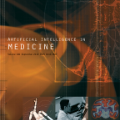Shared-ride mobility services that incorporate traveler walking legs aim to reduce vehicle-kilometers-travelled (VKT), vehicle-hours-travelled (VHT), request rejections, fleet size, or some combination of these factors, compared to door-to-door (D2D) shared-ride services. This paper provides a review of shared-ride services with walking legs (SRSWL), particularly the studies in the literature that model the operational problem(s) associated with SRSWL. The paper describes the operational and societal benefits of SRSWL as well as compares the SRSWL to circuitous D2D shared-ride services, ride-hailing services, and fixed-route transit services, in terms of VKT and traveler walking distance. The paper then delineates the operational subproblems associated with the SRSWL and discusses their computational complexity. Additionally, the review classifies configurations of SRSWL based on flexibility in assigning travelers to pickup and drop-off locations. The paper also discusses four modelling challenge: short-distance person trips, drop-off location choice for a vehicle's last remaining passenger, allowing vehicles to wait for travelers at pickup locations, and simultaneously reducing VHT/VKT and improving customer service quality relative to D2D shared-ride services. The review paper concludes by discussing the most critical areas of future research related to SRSWL.
翻译:包含旅行者步行腿的共享移动服务,旨在减少车辆-公里旅行(VKT)、车辆-小时旅行(VHT)、请求拒绝、车队规模或这些因素的一些组合,与门到门(D2D)共用的共享服务相比较,本文件回顾了与步行腿(SRSWL)有关的共享移动服务(SRSWL),特别是模拟与SRSWL有关的业务问题的文献中的研究报告。本文件描述了SRSWL的业务和社会效益,并将SRSWL与接连的D2D共享服务、乘载服务、固定路由服务、车辆-行走距离(VKT)或旅行者行走距离(D2)相比,进行了对比。本文件随后阐述了与行行走腿(SRSWL)相关的业务次级问题,并讨论了其计算复杂性。此外,审查对SRSWL的配置进行了分类,其依据是将旅行者指派到上下游地点的灵活性。 本文还讨论了四个建模挑战:短途旅行,降低SR-目的地的共享服务,同时将SWM-RM的目的地选择用于与K相关的客车相关的目的地。



